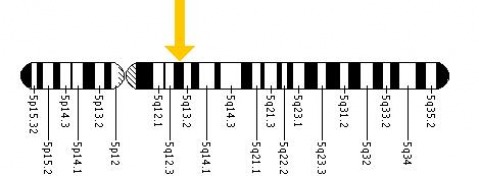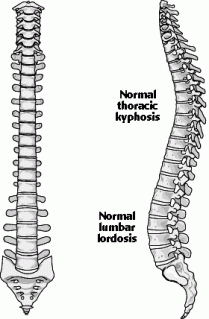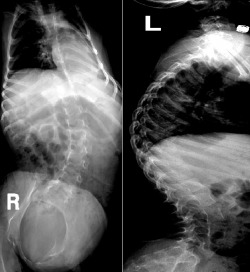This web page was produced as an assignment for Genetics 677, an undergraduate course at UW-Madison
Spinal Muscular Atrophy
Spinal Muscular Atrophy(SMA) results from the absence of or mutation in the SMN1 gene. The SMN1 and SMN2 genes normally produce the survival of motor neuron protein. This protein is necessary for the survival of motor neurons. These are utilized by the brain in order to control voluntary muscles. Without this protein the spinal cord will be incapable of communicating with muscles causing them to become weak due to lack of use and eventually atrophy.(1) This disease results in increased weakness and prevents those afflicted by it to easily move. It can eventually impair their ability to breathe and lead to death. The life expectancy of those with the disease depends upon how it affects respiratory muscles.(2) Earlier onset of the disease is generally more problematic, but the severity is is the main factor determining the lifespan of those affected.
Figure 1
SMN1 - Survival Motor Neuron 1, telomeric
SMN1 is located on the 5th chromosome at position q11.2-13.3. It is responsible for the procution of the survival motor neuron protein. The absence or mutation of this gene is the cause of spinal muscular atrophy. SMN2 is closely related to SMN1. The difference is that it produces a truncated version of the necessary protein. For this reason, it is not sufficient to make up for the absence of SMN1.(3)
Major types of SMN:
(1)(defined by the time of onset)
Type I Acute - <6 months after birth
Type II Intermediate - age 6 - 18 months
Type III Mild - 18 months - early adulthood
Type IV Adult Onset - adulthood
Statistics:
1 in 35-40 Americans are carriers(1)
>25,000 Americans suffer from the disease(1)
1 in 10,000 infants worldwide have SMN(3)
Males are affected more often than females
It is the genetic disease responsible for the most infant deaths.(4)
Normal vs. SMA spine
References:
1. Spinal Muscular Atrophy Foundation (2009) About SMA retrieved Feb 3, 2009 from: http://www.smafoundation.org/index.php?option=com_faq&Itemid=32&Itemid=32
2.Medline Plus (2009) Spinal Muscular Atrophy retrieved Feb 3, 2009 from: http://www.nlm.nih.gov/medlineplus/spinalmuscularatrophy.html
3.eMedicine (2009) Spinal Muscular Atrophy retrieved Feb 3, 2009 from: http://emedicine.medscape.com/article/1181436-overview
4.Fight SMA What is Spinal Muscular Atrophy retrieved Feb 3, 2009 from: http://www.fightsma.org/index.php?what_is_sma
5. (Figure 1) Genetics Home Reference (2007) Where is the SMN1 gene located? retrieved Feb 3, 2009 from: http://ghr.nlm.nih.gov/gene=smn1
6.(Figure 2) University of Cincinnati (2008) Make a Wish retrieved Feb 3, 2009 from: http://greeklife.uc.edu/index.cfm?fuseaction=home.viewPage&page_id=EA5735CF-AADE-0DE3-A6671244E023FD1E
7.(Figure 3) University of Washington Radiology (2008) Scoliosis retrieved Feb 25, 2009 from: http://www.rad.washington.edu/academics/academic-sections/msk/teaching-materials/online-musculoskeletal-radiology-book/scoliosis
8.(Figure 4) ISPUB (2008) Anaesthesia for Spinal Muscular Atrophy retrieved Feb 25, 2009 from: http://www.ispub.com/ostia/index.php?xmlFilePath=journals/ija/vol16n2/spinal.xml
William Baader
[email protected]
Feb 25 2009
www.gen677.weebly.com




